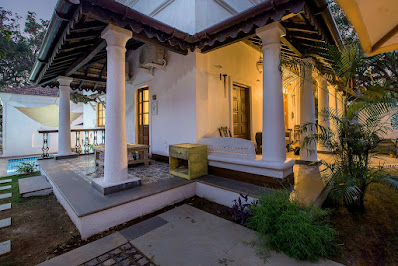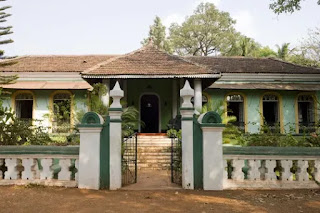 |
| Old Goa house. mid-day.com |
 |
| Goan-Portuguese styled villa, Goa. facebook.com |
The Portuguese who first established the sea-route to India via Indian Ocean and the Arabian sea, ruled Goa for more than 400 years before it became free in 1961, and many native home designs conceived by the natives retained the local style with Portuguese influence. Verandah, columns and red roof tiles were not new to India and in Goa these elements gave special appearance to the homes and buildings. The villa type mansions with fine interior are close to the beach beach. Countless houses in the state of Goa have architectural elements of Portuguese and when Goa had been a Portugal colonial settlement for a long time since the early part of the 16th century, the colonists introduced western architectural elements in Goa and other places in India. The original style is conspicuous in the traditional places of worship like churches, etc. and also in public and residential buildings. The traditional architecture and styles include clay and heritage tiles, mother of pearl shell window, cornices, compound walls including gates, columns or pilasters, use of porcelain and above all exterior and interior colors. Moldings, ornate features and details and railings with intricate design in the houses highlight Portuguese architecture.
 |
| Location map Goa state, India. thegoavilla.com |
The style gives importance to the façade of the structure and most houses have symmetrical frontage with three divisions with connection, richly ornamental arched windows with stucco moldings were present in the houses. These moldings and other ornate elements and details were part of Portuguese architecture. Railing got special attention and was the most intricate element in the house. Round in shape with thick walls made of stone without mortar, the roofs are mostly slanting to drain out rain water.
According to some experts Goa's distinctive architectural style is misunderstood and misinterpreted by the realtors. The Portuguese as years went by had neither money nor interest in building richly ornamental and well-embellished buildings in Goa unlike the British invaders whose income from the Indian subcontinent was vast and had the money and enterprise to build palatial buildings. Many of the Portuguese buildings until their leaving the Indian shores were conceived, planned and executed by native Indian talents. Though not ornamental with impressive architectural styles like vaulted halls, ornate pillars, flying buttress, etc., Portuguese -styled structures were equally attractive and make the visitors look at them for the second time. Equally impressive were the interior furnishings and and beautiful antique wooden furniture.
In the realm of housing around the world, the houses that came up between the 18th and early 20th centuries in Goa stand apart in a separate identity with the fusion of so many elements introduced by the natives of Goa. Clubbing them within the confines of native Portuguese style and architecture is anathema to countless Goans. Realtors using Portuguese architecture as a gimmick are doing injustice to to the local talents available in the past. The State Department of Tourism also does the same ting and it cleverly uses Portuguese colonial rule as a cloak and makes Goa a fine exotic Portuguese destination, not highlighting several inherent factors and cultural aesthetics native to this small state.
The unique-styled houses that you see in Goa do not exist in Latin America or in Portugal. Nor do they exist in any of the countries where Portuguese had a strong influence. Many Goan historians and architects are particular about their native pride and artistic talents. They were free to express their artistic, cultural aesthetic preferences. This is the reason why the Goan architecture is hybrid in natures taking inspiration from various native architectures - Hindu, Muslim, Jain, etc.
The colonial buildings of Mumbai, Kolkata and Chennai are different from the architecture of Goa. In the case of former, Gothic or Neo-Gothic style of design was imposed on the native space designed by British architects incorporating European elements. In the latter case, buildings in Goa were conceived and built by the natives after negotiations with the owners or authorities. In the case of church buildings, besides priests Goan architects, Goan mason and the local communities played no less role in completing such structures. The architectural style of many stunning houses and churches in Goa carry an aura about them imposed by an amalgamation of cultural ethos native to Goa. Hence, they are Indo-Goan style. AS for the British, only in the early 19th century they introduced Indo-Saracenic styled buildings, particularly in Madras (Chennai), borrowing elements from the Muslim and Hindu architecture. Robert Chisholm gave due importance to the value of Native styles and freely incorporated those features to make the buildings more attractive and unique. British architects very much impressed by the old Kerala temple architecture and used certain elements in their work.
Typical Goan houses with Indo-Portuguese style:
The are innumerable indigenously built pretty old Goan-Portuguese homes in the small state of coastal Goa. Unfortunately, in the past many of them had disappeared replaced with modern construction. The primary factors are size of the houses and prohibitive maintenance cost. Conservationists are working hard to create an awareness among the owners to preserve the old houses for the posterity without compromising on heritage elements and the use of old construction techniques.
 |
| Colourful building Fontainhas, Panjim Goa India. alamy.com |
 |
| Goa homes, India theculturetrip.com |
 |
| An old house in a Goan village, India. dsgnarchive.com |
 |
| restored Goan Portuguese home airbnb.ie |
Above image: A meticulously restored Colonial-era century old Goan-Portuguese home, spanning an extensive 10,000 sq ft in the quiet village of Siolim in North Goa
 |
| old Goan mansion. in.pinterest.com |
Above image: 250-year-old Portuguese mansion where the furniture, antiques and newspaper clippings recall wealthy colonial life.
 |
| Residence in Goa, India India Sotheby’s International Realty |
Above image: A table at the garden’s edge. It is close to the house and kitchen. It is a good place to carry on a casual conversations, exchange pleasantries and of course engage in down to earth gossiping.
 |
| Goa residence, Goa. India Sotheby’s International Realty |
Above image: the home, built roughly 75 years ago, has traditional verandas with thick white columns and ornate floor tiles. A spacious veranda around the house cuts down the heat and radiation, and keeps the interior cool. Quite useful to relax in the mooring reading a newspaper or magazine with a hot brew in your hand. .........
 |
| Casa Araujo Alvares, Loutolim,Goa. tripsavvy.com |
Above image: Located in picturesque Loutolim village in Goa is a 250-year-old mansion called Casa Araujo Alvares once owned by the Alvares family. The owner was a prominent lawyer. Native Goa-Portuguese design.............................
 |
| 18th C home, Goa. tripsavvy.com/ |
Above image: 18th century residence, Palacio do Deao (Dean's Palace) was built by Portuguese nobleman Jose Paulo, who founded Quepem town and was Dean of the church there; 11,000 square foot mansion, which blends Hindu and Portuguese architecture, It is just 30 mts drive southeast of Margao. Look at the narrowing open passage with a series of steps. ..............................
 |
| Goan residence, Latin quarters.Panjim Getty images.com tripsavvy.com |
Above image: The stately 400 year-old mansion, one of the largest in the state of Goa. This particular district is UNESCO recognized Heritage area way back in 1984.
 |
Fontainhas, Goa. Wikimedia Commons |
 |
| Goa House, Fountainhas, Indiaamamy.com |
https://www.nytimes.com/2019/12/25/realestate/house-hunting-in-india-portuguese-influence-survives-on-the-coast.html
https://www.tripsavvy.com/portuguese-mansions-tours-in-goa-1539312









